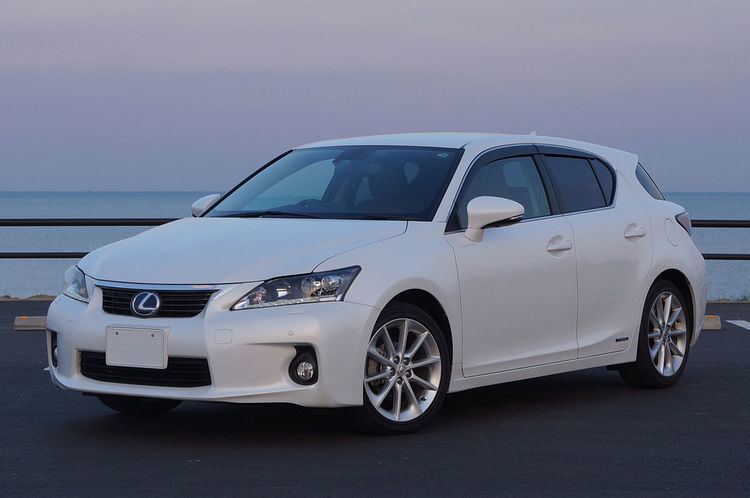Model years 2011–present Class Compact car (C) | Production January 2011–present Designer Takeshi Tanabe | |
 | ||
Assembly Japan: Miyawaka, Fukuoka (Miyata plant) | ||
The Lexus CT 200h (Japanese: レクサス・CT, Rekusasu CT) is a hybrid electric automobile introduced by Lexus as a premium sport compact hatchback. It is the first production model in Lexus's family to introduce the "Spindle Grill" design as seen in its fascia. It made its debut at the March 2010 Geneva Auto Show, six months after the unveiling of the LF-Ch concept car; it is primarily targeted at the European market but is being sold worldwide and was introduced to North American markets at the April 2010 New York International Auto Show. Lexus has trademarked the names CT 200h, CT 300h, and CT 400h. The design by Takeshi Tanabe was approved in 2008 and designs patented on 11 September 2009. Production began at the end of December 2010 and European sales following shortly after. Japan sales began in 12 January 2011, while US sales began in March 2011.
Contents
Designated the model code A10, when fitted with ZR-series petrol engine with hybrid setup, the CT is known as the ZWA10. "CT" stands for "Creative Touring" and "200h" refers to the hybrid performance being equal to that of a conventional 2.0-litre engine. However, some Lexus importers use the backronymic name, "Compact Touring".
Specifications
The CT 200h is powered by the same 1.8-litre VVT-i four-cylinder petrol engine (Toyota's 2ZR-FXE) as used in the Auris and Prius, producing 73 kW (98 hp) and 142 N·m (105 lbf·ft) of torque, paired with electric motor/generators in the hybrid drive system; together the engine and electric motors produce up to 100 kW (134 hp) and 207 N·m (153 lbf·ft) of torque along with an electronically controlled continuously variable transmission. Fuel consumption for the CT 200h is listed at 4.1 L/100 km (57.4 mpg‑US) in Australia.
The CT 200h chassis is based on the Toyota MC platform, which is the same platform used by the Corolla and the Matrix. The Lexus CT 200h features a front MacPherson strut suspension and a rear double wishbone design. The CT 200h has four driving modes Normal, Sport, Eco and EV included on other hybrid drive vehicles. Sport mode modifies the throttle and electric power steering settings, while making the Stability control and traction control less intrusive, maximising the CT200h's performance. EV mode generates zero emissions at the vehicle by using only the vehicles electric motors to drive the vehicle.
Safety features include vehicle stability control (VSC) and eight standard airbags with the options of a pre-collision system with dynamic radar cruise control at extra cost. There is also a Vehicle Proximity Notification System, which uses a low tone to alert pedestrians to the presence of a hybrid motor vehicle, as well as telematic services (Safety Connect in North America).
Facelift
In 2013, for the 2014 model year, the styling of the CT was refreshed, using Lexus' new corporate "Spindle" grille.
Australia
Standard features on the CT 200h include SmartAccess with push-button Start/Stop and touch sensors on exterior front-door handles, leather steering wheel, a six-speaker, audio system with a CD player, and Bluetooth phone connectivity, iPod connectivity, 17-inch aluminum alloy wheels, and dual zone automatic climate control. In Australia, the CT 200h is offered in "Prestige", "Luxury", "F Sport" and "Sport Luxury" specifications. The Luxury, F Sport and Sports Luxury variants add a reversing camera as standard, while the Sports Luxury gains active cruise control and the pre-collision safety system. F Sport models include all the features of the Luxury model, plus sports bumpers, sports side skirts and a large rear spoiler. Interior features of the F Sport are an F Sport steering wheel, sports pedals, scuff plates, instrument panel and privacy glass.
At the 2011 Australian Formula One Grand Prix in Melbourne (25–27 March 2011), the Lexus CT 200h was used in the Celebrity Challenge, a one-make, one-off series event held as part of the Grand Prix's weekend attractions. The event, supported by CAMS and sponsored by Lexus Australia, was promoted as the world's first race containing only petrol-electric vehicles.
North America
In North America, the CT launched in early 2011 for the 2011 model year. The facelift model arrived in 2013 for the 2014 model year. At this time, the "F Sport" package was now offered, including a different variation on the spindle grille and other cosmetic differentiation. No performance enhancements came with the F Sport package, which used visually different wheels but the same tires as the base CT.
Estimated fuel consumption is:
Reception
The Union of Concerned Scientists (UCS) in its 2011 Hybrid Scorecard ranked the Lexus CT 200h, together with the Lincoln MKZ Hybrid, as the top luxury hybrid models in the scorecard's environmental improvement category, an achievement the UCS attributed to their relatively small petrol engines, as both carmakers downsized these vehicles' engines from six to four cylinders to maximize fuel economy. The UCS evaluation found that the Lexus CT 200h reduces greenhouse emissions by 42.9% as compared to the Lexus IS 250, used as its petrol-only similar for this comparison.
Awards
Sales
Global sales of Lexus CT 200h reached 267,000 units through March 2016, making the CT the second best selling Lexus hybrid after the Lexus RX 400h/RX 450h. CT 200h sales represent 26.7 percent of the one million Lexus hybrids delivered since 2005.
*Canadian and U.S. sales began in March 2011.
